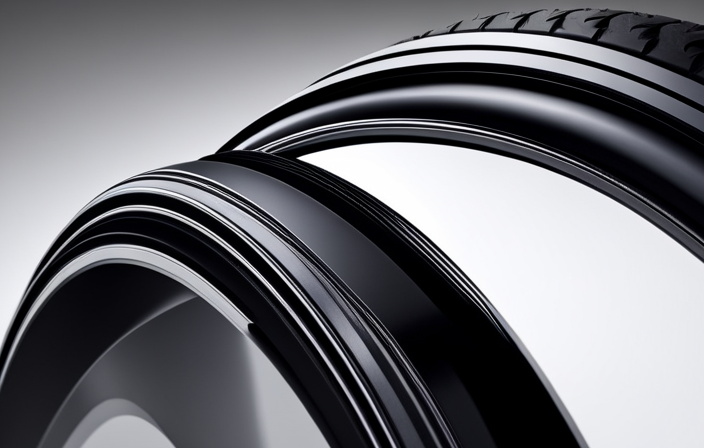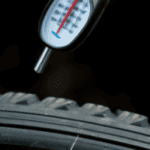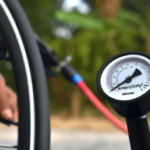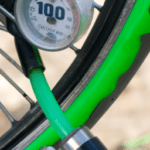Riding a bicycle brings such joy – feeling the wind in your hair and the freedom of the open road.
But wait, have you ever stopped to think about the importance of proper tire inflation? It may seem like a trivial matter, but trust me, it’s not to be taken lightly.
The amount of air in your bicycle tires can greatly impact your riding experience, from performance to safety.
So, let’s delve into the world of tire pressure and discover just how crucial it is to get it right.
Key Takeaways
- Optimal tire pressure improves performance and comfort.
- Overinflating or underinflating tires affects ride quality.
- Regularly check tire pressure with a gauge and adjust as needed.
- Follow manufacturer’s recommended range for optimal tire pressure.
The Importance of Proper Tire Inflation
You need to make sure you have the right amount of air in your bicycle tires to ensure proper inflation. Determining the optimal tire pressure is crucial for a smooth and safe ride.
Riding with underinflated tires can lead to increased rolling resistance, making it harder to pedal and reducing your overall speed. On the other hand, overinflated tires can result in a harsh and uncomfortable ride, as well as reduced traction and control.
Properly inflated tires offer several benefits, including improved handling, better grip on the road, and increased efficiency. Understanding tire pressure ratings is essential to maintaining the correct air pressure in your bicycle tires.
It’s crucial to learn about the recommended pressure range for your specific tire model to ensure optimal performance and safety.
Understanding Tire Pressure Ratings
To properly understand tire pressure ratings, it’s important to consider the recommended psi range for your specific bike. Determining the ideal pressure for your bicycle tires involves calculating the tire pressure accurately. This can be done by taking into account factors such as rider weight, terrain conditions, and tire width.
To calculate the tire pressure accurately, you can refer to a tire pressure chart or use a tire pressure calculator available online. These tools consider various factors to provide you with the recommended psi range.
Here is an example table that demonstrates how tire pressure can vary based on different factors:
| Rider Weight (lbs) | Terrain Conditions | Tire Width (mm) | Recommended PSI Range |
|---|---|---|---|
| 120 | Pavement | 25 | 90-100 |
| 180 | Gravel | 32 | 70-80 |
| 150 | Trail | 35 | 50-60 |
| 200 | Off-road | 40 | 30-40 |
By understanding tire pressure ratings and calculating the appropriate psi range, you can ensure optimal performance and safety for your bike. Moving forward, let’s explore how to determine the correct air pressure for your bike without relying on guesswork.
Determining the Correct Air Pressure for Your Bike
When determining the correct air pressure for your bike, it’s important to consider factors such as rider weight, terrain conditions, and tire width. These factors play a crucial role in determining the optimal pressure for your bicycle tires.
To determine the optimal pressure, start by checking the recommended pressure range indicated on the sidewall of your tires. This will give you a baseline to work with. From there, you can make adjustments based on your weight and the terrain you’ll be riding on.
If you’re experiencing inflation issues, such as frequent flats or poor handling, it’s possible that your tire pressure is too low or too high. Troubleshooting these issues involves finding the right balance of air pressure to ensure a smooth and safe ride.
Considering the different types of bicycles, there are additional considerations to take into account.
[Transition to the subsequent section about ‘considerations for different types of bicycles’.]Considerations for Different Types of Bicycles
Different types of bicycles require varying levels of air pressure for optimal performance and safety. When it comes to mountain bikes, choosing the right tire size is crucial. The tire size will determine the recommended air pressure range.
Generally, mountain bike tires have a wider and knobbier tread compared to road or hybrid bikes. This means that they require lower air pressure to provide better traction and absorb shocks while riding on rough terrains. Proper tire inflation for mountain bikes typically falls within the range of 30-50 psi (pounds per square inch). However, it’s important to consult the manufacturer’s guidelines or the sidewall of the tire for specific recommendations.
With the right tire size and proper inflation, you can confidently tackle off-road trails and enjoy a smooth ride.
Now, let’s move on to the next section about using a bicycle pump with a pressure gauge.
Using a Bicycle Pump with Pressure Gauge
Make sure you use a bicycle pump with a pressure gauge to easily monitor and adjust the air pressure in your tires. This will ensure that you have the right amount of air in your tires for a smooth and safe ride.
When it comes to bike pump maintenance, it’s important to keep your pump clean and free from debris. Regularly check the pressure gauge to ensure its accuracy. There are different types of pressure gauges available, including dial gauges and digital gauges. Dial gauges are more traditional and rely on a needle to indicate the pressure, while digital gauges provide a precise numerical reading. Whichever type you choose, make sure it’s easy to read and understand.
Checking tire pressure before every ride is crucial for optimal performance and safety. Maintaining the right tire pressure can prevent flats and improve handling.
Checking Tire Pressure Before Every Ride
Before you start your ride, be sure to check the tire pressure to ensure optimal performance and safety. Proper tire pressure is crucial, especially when it comes to off-road trails. When riding on rough terrains, it is essential to adjust your tire pressure accordingly.
Lowering the pressure provides better traction, allowing the tires to grip the ground more effectively. This ensures a smoother ride and reduces the risk of losing control on uneven surfaces.
On the other hand, higher tire pressure is necessary for road conditions. It reduces rolling resistance, making it easier to pedal and increasing overall efficiency. Additionally, it affects braking distance, as higher pressure allows for quicker stopping.
So, before hitting the road, take a moment to adjust your tire pressure for optimal performance.
Adjusting Tire Pressure for Road Conditions
Adjusting tire pressure for road conditions is important for optimal performance and safety while riding.
When riding in wet conditions, it is crucial to decrease tire pressure to enhance traction and prevent hydroplaning. Lowering the tire pressure allows the tire to conform to the wet surface, increasing grip and reducing the risk of skidding.
On the other hand, when riding on off-road trails, it is recommended to increase tire pressure to avoid punctures and improve stability. Higher tire pressure helps to prevent the tire from sinking into soft terrain and provides a more secure ride.
It is essential to adjust tire pressure accordingly to ensure a smooth and enjoyable cycling experience. Avoiding overinflation and underinflation is key to maintaining optimal tire performance and preventing accidents.
Transitioning into the next section, let’s discuss how to achieve the perfect tire pressure for your bicycle.
Avoiding Overinflation and Underinflation
To ensure optimal performance and safety while cycling, it is crucial to avoid both overinflation and underinflation of your bicycle tires. Overinflated tires can be just as problematic as underinflated ones, as they may result in a harsh and uncomfortable ride. On the other hand, underinflated tires can negatively affect handling and increase the risk of tire blowouts. It is important to strike a balance and find the recommended tire pressure for your specific bike and riding conditions.
To emphasize the importance of avoiding overinflation and underinflation, consider the following:
- Overinflation can lead to a loss of traction, making it harder to control your bike on slippery surfaces.
- Underinflated tires can cause increased rolling resistance, resulting in a slower and more difficult ride.
Understanding the effects of tire pressure on handling and the potential dangers of underinflated tires sets the stage for our next discussion on how tire pressure impacts performance and comfort.
The Impact of Tire Pressure on Performance and Comfort
Finding the optimal tire pressure for your bike can greatly impact your performance and comfort while riding.
The relationship between tire pressure and tire longevity is crucial to understand. Overinflating your tires can cause excessive wear and tear, leading to a shorter lifespan for your tires. On the other hand, underinflating them can result in increased rolling resistance and a higher risk of pinch flats.
Additionally, tire pressure plays a significant role in cornering ability. Higher pressures provide a more stable and responsive feel, allowing you to take corners with confidence. However, too much pressure can reduce traction and make your bike feel harsh on rough roads.
It’s important to find a balance that suits your riding style and the conditions you encounter. Maintaining optimal tire pressure ensures a smooth and safe ride. Now, let’s explore some tips for achieving this.
Tips for Maintaining Optimal Tire Pressure
To maintain optimal tire pressure, you should regularly check and adjust your tire pressure according to the recommended range specified by the manufacturer. Proper tire pressure maintenance is crucial for ensuring a smooth and efficient ride, as well as prolonging the lifespan of your tires. Here are some tips to help you maintain optimal tire inflation:
| Check Tire Pressure | Adjust Tire Pressure | Monitor Tire Wear |
|---|---|---|
| Regularly check your tire pressure with a pressure gauge. | Adjust the tire pressure using a floor pump or a handheld pump. | Monitor your tire wear for signs of over or underinflation. |
By following these steps, you can ensure that your bike tires are always inflated to the optimal pressure. This will result in improved performance, comfort, and safety during your rides. Now, let’s move on to the next section and discuss common mistakes to avoid when inflating bike tires.
Common Mistakes to Avoid When Inflating Bike Tires
When it comes to maintaining optimal tire pressure, it’s important to avoid common mistakes that can affect your ride. One of the most common mistakes is overinflating or underinflating your bike tires. Overinflating can cause a harsh ride and increase the risk of a blowout, while underinflating can make your tires prone to flats and decrease your bike’s performance.
To avoid these issues, it’s crucial to use proper inflation techniques. Start by checking the recommended tire pressure listed on the sidewall of your tires. Use a reliable pressure gauge to ensure accurate readings, and gradually add or release air until you reach the desired pressure. Remember to periodically check your tire pressure to maintain optimal performance.
By avoiding these common mistakes and following proper inflation techniques, you can enjoy a smoother ride and reduce the risk of tire-related issues.
Now, let’s move on to the benefits of regular tire maintenance…
The Benefits of Regular Tire Maintenance
Maintaining your bike’s tires regularly can significantly improve your riding experience and enhance your bike’s overall performance. Regular tire maintenance not only ensures the longevity of your tires but also maximizes efficiency and improves safety while riding. By keeping your tires properly inflated, you can reduce rolling resistance and increase speed, making your rides smoother and more enjoyable. Additionally, regular tire maintenance helps prevent flats and blowouts, reducing the risk of accidents and injuries. To highlight the importance of tire maintenance, consider the following table:
| Benefits of Regular Tire Maintenance | ||
|---|---|---|
| Maximized Efficiency | Improved Safety | Enhanced Performance |
| Reduced Rolling Resistance | Fewer Flats | Increased Speed |
| Longer Tire Lifespan | Better Handling | Smoother Rides |
Taking the time to maintain your bike’s tires ensures optimal performance and safety. Now, let’s explore how weather conditions affect tire pressure.
How Weather Conditions Affect Tire Pressure
Weather conditions can have an impact on tire pressure. It is important to measure tire pressure accurately to ensure optimal performance and safety. When it comes to measuring tire pressure, using a reliable pressure gauge is crucial. This will give you precise readings and help you determine if your tires need more air or if they are overinflated.
Additionally, it is important to consider the effect of altitude on tire pressure. As you go to higher altitudes, the air pressure decreases, which means that your tires may lose pressure. It is important to regularly check and adjust the tire pressure accordingly, especially if you frequently ride in mountainous areas. Understanding how weather conditions and altitude affect tire pressure will help you maintain optimal tire performance.
Now, let’s discuss the role of tire width in determining air pressure.
The Role of Tire Width in Determining Air Pressure
Now that we understand how weather conditions can affect tire pressure, let’s delve into the role of tire width in determining air pressure.
The width of your bicycle tires plays a crucial role in the overall performance of your ride. A wider tire will generally require less air pressure compared to a narrower one. This is because a wider tire has a larger contact patch with the ground, distributing the rider’s weight more evenly and reducing the need for high pressure.
Conversely, a narrower tire requires higher pressure to maintain its shape and prevent pinch flats. It’s important to find the right balance between tire width and air pressure to optimize handling and ride quality.
Speaking of handling, tire pressure directly impacts how your bike handles on different terrain, affecting grip, stability, and maneuverability. With this understanding of how tire width affects performance and the impact of tire pressure on handling, we can now explore the recommended tire pressure for different riding styles.
Recommended Tire Pressure for Different Riding Styles
To optimize your ride quality and handling, it’s important to know the recommended tire pressure for different riding styles.
When it comes to mountain biking, tire pressure plays a crucial role in providing the right amount of traction and control. For off-road trails and rough terrain, a lower tire pressure is recommended. This allows the tire to conform to the uneven surfaces, providing better grip and stability. However, it’s important not to go too low as it can increase the risk of pinch flats and rim damage.
On the other hand, for commuting on paved roads, a higher tire pressure is preferred. This reduces rolling resistance and improves efficiency. It also helps to prevent flats caused by road debris.
It’s recommended to consult the tire manufacturer’s guidelines or seek advice from experienced riders to determine the optimal tire pressure for your specific riding style.
Frequently Asked Questions
What are the recommended tire pressure levels for different riding styles?
For mountain biking, the recommended tire pressure levels are typically lower to provide better traction and shock absorption. On the other hand, for road cycling, optimal tire pressure is usually higher to minimize rolling resistance and increase speed.
How do weather conditions affect tire pressure?
Temperature and humidity both affect tire pressure. As the temperature rises, tire pressure increases. Conversely, colder temperatures cause tire pressure to decrease. Humidity can also cause tire pressure to fluctuate. It’s important to regularly check and adjust tire pressure accordingly.
Does tire width play a role in determining the required air pressure?
Tire width does play a role in determining the required air pressure. Wider tires generally require lower pressure for a smooth ride and better traction. However, lower pressure can increase rolling resistance, so it’s important to find the right balance.
Can you overinflate or underinflate your bike tires? What are the consequences?
You can definitely overinflate or underinflate your bike tires. Overinflating can lead to the dangers of decreased traction and a harsh ride, while underinflation can result in poor handling and increased risk of punctures.
What are some common mistakes to avoid when inflating bike tires?
Avoiding punctures and maintaining proper tire pressure are crucial for bike performance. To prevent common mistakes, I suggest checking for debris, using a reliable pump, and ensuring a snug fit.
Conclusion
In conclusion, proper tire inflation is absolutely crucial for a smooth and efficient bike ride. Trust me, you don’t want to underestimate the power of a well-inflated tire!
By understanding tire pressure ratings, considering the type of bike you have, and using a pump with a pressure gauge, you can ensure that your tires are perfectly inflated for your riding style.
Regular tire maintenance is key to avoiding any unexpected surprises on your journey. So remember, don’t underestimate the importance of air in your bicycle tires – it’s truly the secret to an exceptional ride!
















